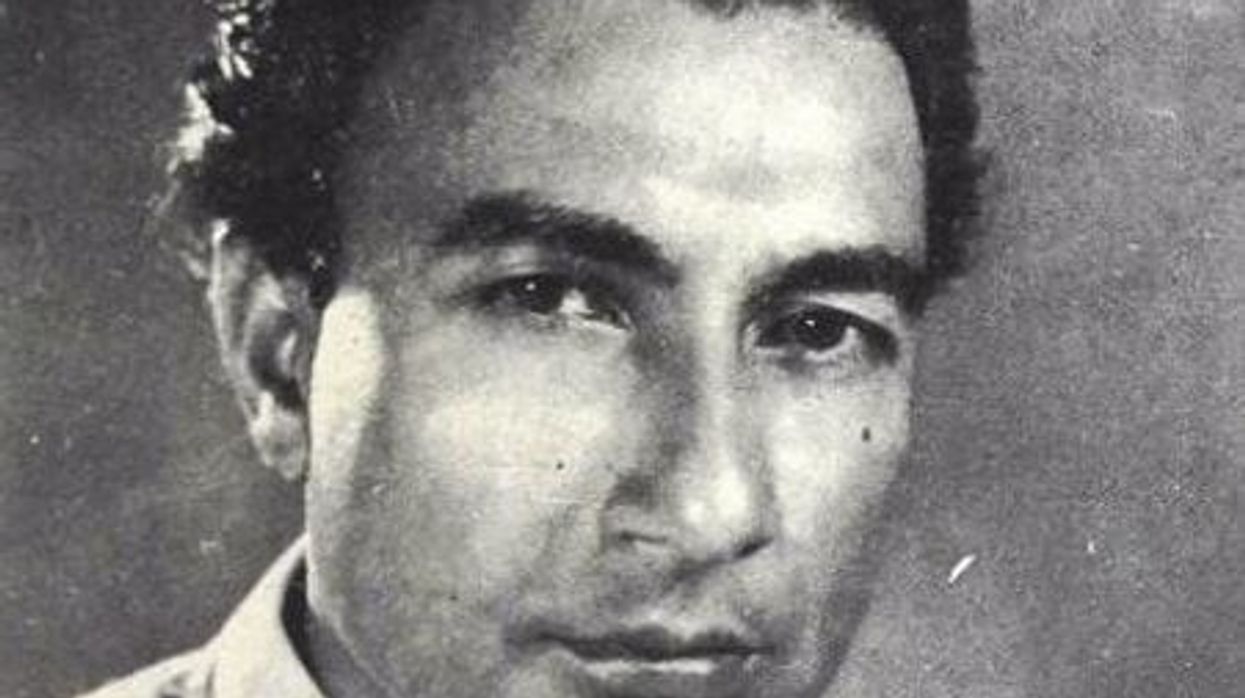ONE of the greatest lyricists in the history of Hindi cinema, Sahir Ludhianvi used his remarkable talent with words to write timeless songs that have entertained generations of music fans.
In addition to creating an extraordinary body of work, he inspired singers, musicians, lyricists, filmmakers, and popular culture with his poetic brilliance. Affectionately known as the people’s poet, he combined emotional, social, and philosophical depth in his songs before his untimely passing on October 25, 1980, at the age of 59.
To mark his death anniversary this month, Eastern Eye has curated a playlist of 20 iconic tracks spanning his career, limiting ourselves to one per film.
Thandi Hawayein from Naujawan (1951): The poet-turned-lyricist’s first major success came after teaming up with composer SD Burman for this breezy romantic number, sung by Lata Mangeshkar. The evocative lyrics express the tenderness of love and longing, using cool breezes and moonlit nights to enhance the romance in this atmospheric song.
Tadbeer Se Bigdi Hui Taqdeer Bana from Baazi (1951): After a steady start to his career, Ludhianvi found fame with filmmaker Guru Dutt’s directorial debut, which featured this upbeat song about taking control of one’s destiny. Geeta Dutt’s vocals beautifully conveyed motivational and reflective lyrics that were inspiring, optimistic, and philosophical.
Jaaye To Jaaye Kahaan from Taxi Driver (1954): Everyone has experienced feeling lost and searching for direction at some point in life. This song, delivered by Talat Mahmood, wonderfully captured that emotion. The deep lyrics, effortlessly reflecting existential angst, connected with those who felt unsure about their path, and they still resonate today, 70 years later.
Ab Aage Teri Marzi from Devdas (1955): Among the many adaptations of the classic novella Devdas, this version is considered the greatest. The film’s music seamlessly fit the narrative, including this courtesan song that reflects an acceptance of unrequited love. Beneath its surface as a dance number, the lyrics conveyed deep emotion and a profound message.
Uden Jab Jab Zulfen Teri from Naya Daur (1957): Ludhianvi penned several hit songs for this game-changing blockbuster, but this playful number stood out. It perfectly captured the youthful charm of love, with a catchy beat by OP Nayyar and the captivating vocals of Mohammed Rafi and Asha Bhosle elevating this flirtatious track.
Jaane Woh Kaise Log The Jinke from Pyaasa (1957): This film’s soundtrack is regularly ranked among the greatest in Bollywood history. While Ludhianvi wrote many iconic songs for Pyaasa, including Jaane Kya Tune Kahi, Ye Duniya Agar Mil Bhi Jaye, and Sar Jo Tera Chakraye, this melancholic masterpiece stands out. Sung by Hemant Kumar, the lyrics beautifully reflect the irony and pain of unreciprocated love, a lament for those who find happiness while others remain heartbroken.
Aurat Ne Janam Diya Mardon Ko from Sadhana (1958): After writing blockbuster hits throughout the 1950’s, This impactful song earned Ludhianvi his first Filmfare best lyricist nomination. Sung by Lata Mangeshkar, the lyrics call out the contradictory nature of how women are revered yet mistreated by society. The powerful feminist message was ahead of its time, and its critique of gender inequality remains relevant today. It highlights the hypocrisy in how women are treated.
Ludhianvi with Lata MangeshkarTu Hindu Banega Na Musalman Banega from Dhool Ka Phool (1959): Bollywood’s greatest filmmaker, Yash Chopra, began his directorial journey with this film, marking the start of a dream partnership with Ludhianvi. The standout song was this universal anthem about communal harmony and the futility of religious divisions. Sung by Mahendra Kapoor, the lyrics express sentiments that humanity transcends religious identities. The simple yet powerful message of unity remains timeless.
Na To Karwan Ki Talash Hai from Barsaat Ki Raat (1960): The blockbuster soundtrack composed by Roshan was packed with beautiful songs, and the best of these was this poetic qawwali. Sung by Mohammed Rafi and Manna Dey, this qawwali is one of Bollywood’s most famous, celebrating the universal quest for love and spirituality. The uplifting lyrics were brought to life by an ensemble of singers and remain a highlight of Ludhianvi’s work.
Abhi Na Jao Chhod Kar from Hum Dono (1961): This delightful duet, sung by Mohammed Rafi and Asha Bhosle, regularly ranks as one of Bollywood’s greatest love songs. The playful yet poignant plea for a loved one to stay a little longer is filled with romance, affection, and longing. The song perfectly captures the reluctance to part from someone you adore. Honourable mention also goes to Mai Zindagi Ka Saath Nibhata Chala Gaya from the same film.
Jo Waada Kiya Woh Nibhana Padega from Taj Mahal (1963): The wonderful wordsmith finally won his first Filmfare best lyricist award for this unforgettable duet, sung by Lata Mangeshkar and Mohammed Rafi. The lyrics poetically express a vow of undying love and the promise to fulfil it, no matter the obstacles. This lyrical promise of eternal devotion turned the song into a timeless romantic masterpiece.
Chalo Ek Baar Phir Se from Gumrah (1963): The words of this Filmfare-nominated song perfectly capture the pain of lost love and the yearning to restart a relationship. Sung by Mahendra Kapoor, Ludhianvi’s melancholic lyrics evoke a sense of resignation to fate, reflecting the complexities of human relationships.
Laaga Chunari Mein Daag from Dil Hi To Hai (1963): This song, composed by Roshan and sung by Manna Dey, became a timeless classic with its metaphorical description of the tarnishing of a pure soul, using the imagery of a stained veil. The philosophical lyrics explore themes of purity, honour, and sorrow. The timeless track would become culturally significant.
Chhoo Lene Do Nazuk Honthon Ko from Kajal (1965): While the song appears to be about drinking, it’s actually a cleverly disguised expression of love, desire, and reverence. Sung by Mohammed Rafi, Ludhianvi’s multi-dimensional lyrics use various metaphors to express deep passion. This layered and sensual track showcases his lyrical brilliance in conveying complex emotions.
Ae Meri Zohra Jabeen from Waqt (1965): There may not be a better song in Bollywood history that celebrates mature love. It pays tribute to the beauty of a long-term partner after years of marriage. Ludhianvi’s lyrics reflect deep affection and respect, adding emotional depth to the song. This tribute to enduring love reappeared decades later in the record-breaking film Dilwale Dulhania Le Jayenge (1995).
Aaja Tujhko Pukare Mera Pyar from Neel Kamal (1968): This is one of the greatest songs to express deep longing for someone. Sung by Mohammed Rafi, the lyrics convey the pain of separation and the yearning to reunite with a loved one. Ludhianvi’s soulful words made this one of Bollywood’s most moving romantic numbers of all time.
Milti Hai Zindagi Mein Mohabbat from Ankhen (1968): This Filmfare-nominated song, sung by Mahendra Kapoor and composed by Ravi, reflects the bittersweet nature of love and longing. Ludhianvi’s introspective lyrics capture the melancholy of unfulfilled love and the fleeting essence of love. The song’s deep emotional resonance makes it a timeless classic.
Mere Dil Mein Aaj Kya Hai from Daag (1973): This iconic movie marked the launch of the legendary production house Yash Raj Films. Featuring a simple yet captivating melody, this Laxmikant-Pyarelal composition is considered the finest song in the film. Sung by Kishore Kumar, the romantic lyrics express the vulnerability and sincerity of a lover opening their heart, making this a deeply soulful track.
Husn Hazir Hai from Laila Majnu (1976): Based on the iconic love story of Laila and Majnu, the romantic drama demanded powerful love songs, and Ludhianvi delivered. Several tracks from the movie could have made this list due to their significant impact. But Lata Mangeshkar’s soulful vocals added emotional depth and intensity to this song.
Kabhi Kabhie Mere Dil Mein from Kabhi Kabhie (1976): Widely regarded as one of Bollywood’s greatest love songs, this simple yet profound ballad, sung by Mukesh, explores love as a memory that lingers over time. The introspective lyrics, filled with emotional depth, continue to captivate new generations. Ludhianvi’s Main Pal Do Pal Ka Shayar Hoon from the same film has also left a lasting legacy.






 The Christmas light walks in central London that still feel festive Getty Images
The Christmas light walks in central London that still feel festive Getty Images 





